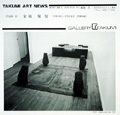The process of modernization in Okinawan society was over in early
1980's. Landscapes changed and Okinawa came out from its old image of
islands of tragedy to southern paradise. As a highly consumer-oriented
economy and culture started to penetrate into Okinawa, Okinawan local rituals and indigenous ceremonies became "festival of southern island." In a sense,
Okinawan ethnicity became a commodity and was consumed as a sign in post-modern society.
As Okinawa began to share common aspects of mainland Japan,
it started to reconsider its locality, longing for Okinawa's identity. Looking at
the Okinawan art scene in this period, it can be said that goal of modernism
in post-war period was technically achieved. Private and public galleries
opened one after another and a number of exhibitions increased with
urbanization. It seemed that in this period, paradigm shift occurred in
Okinawas' mentality. Okinawans developed an inferior complex when they
compared themselves to mainland Japan but later realized it was more of a
cultural difference. After Okinawan artists accomplished the first goal to be
equal with mainland Japanese artists technically, then they started to look at differences positively between Okinawa and mainland Japan.
After the arrival of new teachers such as Teizo Nagatsu, from mainland to University of the Ryukyus caused a positive influence to the Okinawan art
scene. They joined young local artists and established galleries and curated
exhibitions by themselves. Kojiro Nose and Yuko Nose introduced a new
horizon of sculpture by organizing symposiums. They worked with a concept of space and relationship.
Also new generation of artists appeared; Eiji Aoyama and Morihiro
Yamauchi were the artists who had already internalized the language of
contemporary art.
|
 |